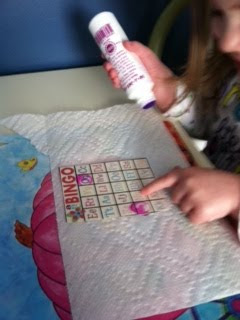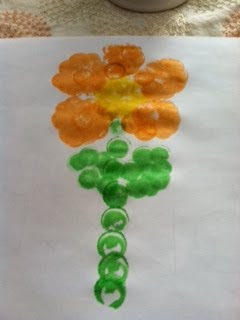Playing with letter tiles is a free, easy way for kids to have fun with letters. Most families probably have an old Scrabble game in a closet somewhere that has been collecting dust. Our letter tiles are from Bananagrams that I play maybe once a year. The Pea loves to play with the letter tiles. She always wants me to make her name, then my name, then Daddy's name, and her sister's name. Lately she has been putting the letters together and asking me, "What does that say?" I feel bad saying that it says nothing so I just read it phonetically and end up saying nonsense words like PNNTLO. But she likes it and it's something to do on a rainy day! Since she can spell her name verbally, I often ask her to tell me how to spell her name for practice and I also ask her to look for the letters. I also begin her name with the C and ask her to place the next letters. This teaches her left to right directionality, words are formed from left to right.
This is definitely an activity that requires supervision since the letter tiles are small and could become a chokable. We never use these with Anna nearby! They do provide a nice alternative to magnetic letters since the magnets present an even bigger danger to children.
Friday, March 30, 2012
Thursday, March 29, 2012
Alphabet Bingo
Whenever the Pea and me do "Mommy School" we have a letter of the day. All I really do with it is show her the uppercase and lowercase letter and tell her the sound. I name a few things that begin with the letter. Then she has to find it in a stack of flashcards. Since yesterday's letter of the day was Zz we celebrated today by taking a break from the normal routine. I found these Alphabet Bingo cards on Pinterest a while back and have been saving it for a rainy day! They came from www.sassysanctuary.com. The writer of the blog made 8 different cards that you can print out to use with your little one. This is great for letter identification - either learning or assessment/review. Since the Pea already knows all of her uppercase letters, I used this as an assessment/review by calling out letter names randomly using my stack of alphabet cards. The Pea used the Do-a-Dot dotter to mark the letters as they were called.
It was also good hand-eye coordination practice to mark the letter with the dotter since she had to do it carefully so as not to mark the wrong letter. When she filled a row I taught her to yell BINGO, which she enjoyed thoroughly. Then she dotted the rest of her card shouting the letters while she was doing so. She proudly said, "I am going to show Daddy when he gets home!"
Alphabet Bingo can be used with little ones to practice letter identification by holding up the flashcard with the letter on it, naming the letter, and then having her find the letter on her card.
It was also good hand-eye coordination practice to mark the letter with the dotter since she had to do it carefully so as not to mark the wrong letter. When she filled a row I taught her to yell BINGO, which she enjoyed thoroughly. Then she dotted the rest of her card shouting the letters while she was doing so. She proudly said, "I am going to show Daddy when he gets home!"
Alphabet Bingo can be used with little ones to practice letter identification by holding up the flashcard with the letter on it, naming the letter, and then having her find the letter on her card.
Wednesday, March 28, 2012
Dot Art Flower
Claire loves Dot Art! And if Claire is happy, I'm happy! So when Claire asked to do Dot Art this morning, I said "Sure!". And to tie in our flower theme, I suggested that we make flowers.
First get yourselves some Do-a-Dots. I bought these with a 50% off coupon at Michael's!
I showed the Pea how to make a Dot Art flower.
And here is the little artist herself making hers. Isn't it spectacular?!
Then she wanted to make one for her swim teacher since we were going to her swim lesson later on in the morning. She chose blue dots. And then asked me to make a flower. Unfortunately we forgot to bring her Dot Art with her to swim class which caused a major meltdown in the pool. Notice the small cluster of blue dots that form a line. She did that herself! This took some serious fine motor skills! I have been trying to get her to make a straight line with Do-a-Dots for a while now, so this was kind of a big deal in our house. You can incorporate color names, parts of a flower, and making patterns during this activity.
First get yourselves some Do-a-Dots. I bought these with a 50% off coupon at Michael's!
I showed the Pea how to make a Dot Art flower.
And here is the little artist herself making hers. Isn't it spectacular?!
Then she wanted to make one for her swim teacher since we were going to her swim lesson later on in the morning. She chose blue dots. And then asked me to make a flower. Unfortunately we forgot to bring her Dot Art with her to swim class which caused a major meltdown in the pool. Notice the small cluster of blue dots that form a line. She did that herself! This took some serious fine motor skills! I have been trying to get her to make a straight line with Do-a-Dots for a while now, so this was kind of a big deal in our house. You can incorporate color names, parts of a flower, and making patterns during this activity.
Labels:
art activities,
Do-a-Dot,
fine motor activities,
Flowers
Tuesday, March 27, 2012
Flower Sensory Tray
For the Flower sensory tray I went to the dollar store and bought some fake flowers and fern. I had been saving some of the seeds from fresh fruits and veggies that I had been making last week. Just rinse them and set them on the windowsill for a few days to dry out. The sensory tray is just a mud tray I found at Target. I introduced the Sensory tray by skimming Zinnia's Flower Garden which we read yesterday. And then I showed her what was on the tray to explore. You can use the sensory tray time to introduce vocabulary words and discuss texture and feeling words. Here is the coversation the Pea and Me had: The Pea: I smell it. Achoo! Me:What happened? The Pea: I smelled the flower so I sneezed. Me: Do you think flowers smell? The Pea: Yeah. They smell like dirt. Me: What do you think plants need? They need soil. More cereal. I need to water plants. I need a watering can. Then the Pea got really hung up on watering her flowers. She wanted a watering can to fill with water. I tried to convince her to use her fake pitcher from her play kitchen and pretend but she was not having it. And since she couldn't get her way she didn't want to play with the sensory tray any more! (Sigh) Kids... :)
Monday, March 26, 2012
Theme of the Week: Flowers
To kick off this week's theme I read Zinnia's Flower Garden by Monica Wellington. This book was a gift from my mom last spring and it was the perfect story to read to the Pea! It kept her engaged the hole time and provides detailed illustrations of seeds, flowers, butterfly life cycle, and more. The book describes how Zinnia plants her flower garden and what she has to do to care for her plants. This book has a simple storyline for my 2 1/2 year old but includes more advanced information for older children. I definitely would have read this book to my third graders during our plant unit.
Friday, March 16, 2012
Creating an Environment that Supports Emergent Literacy
Although we often assiciate school with beginning reading and emerging literacy skills, the preschool years are when a large amount of literacy development occurs. It is a critical time for emergent literacy - motivation is high, children's brains are developing, and there are many ways to promote literacy. In his book Reading Instruction that Works: A Case for Balanced Teaching Michael Pressley outlines four ways that parents can create an environment that supports literacy. I have listed these and included practical examples.
1) Experiences with family - exposing your child to new places and activities introduces them to new words, new feelings, new experiences. They are able to build their vocabulary and expand their background knowledge so that when they are reading they recognize words and are able to make connections to the text, which aides in their comprehension. Take children to a zoo, a parade, the grocery store, a farm, a creek, your backyard, a soccer game. Experiences as toddlers will actually help them later on when they are reading!
2) Provide an environment with literacy materials easily accessible - stock your bookshelves of age-approriate books of all genres. Put magnetic letters on your fridge. Include alphabet puzzles in your child's toy collection. Allow your child to use crayons, markers, sidewalk chalk. Write a letter to grandma so that your child can see writing take place.
3) Children need to see adults have a positive view of literacy - read in front of your child. Show them that you like reading. Studies have correlated reading success with children seeing their parents read. They learn through imitation. So, read the paper or a novel in front of your child.
4) Share in experiences with your child. Read to them, invite them to read to you (even if they can't really read yet!), talk about the book you are reading, do alphabet puzzles, write together. Making reading and writing enjoyable for them now will help them to become lifetime lovers of literacy.
1) Experiences with family - exposing your child to new places and activities introduces them to new words, new feelings, new experiences. They are able to build their vocabulary and expand their background knowledge so that when they are reading they recognize words and are able to make connections to the text, which aides in their comprehension. Take children to a zoo, a parade, the grocery store, a farm, a creek, your backyard, a soccer game. Experiences as toddlers will actually help them later on when they are reading!
2) Provide an environment with literacy materials easily accessible - stock your bookshelves of age-approriate books of all genres. Put magnetic letters on your fridge. Include alphabet puzzles in your child's toy collection. Allow your child to use crayons, markers, sidewalk chalk. Write a letter to grandma so that your child can see writing take place.
3) Children need to see adults have a positive view of literacy - read in front of your child. Show them that you like reading. Studies have correlated reading success with children seeing their parents read. They learn through imitation. So, read the paper or a novel in front of your child.
4) Share in experiences with your child. Read to them, invite them to read to you (even if they can't really read yet!), talk about the book you are reading, do alphabet puzzles, write together. Making reading and writing enjoyable for them now will help them to become lifetime lovers of literacy.
Tuesday, March 13, 2012
Green Sensory Tray
Sticking with GREEN as the theme for this week I gathered together some items that were green for the Pea's sensory tray. Grass, plastic bugs, shamrocks, her Percy train, and more items were present.
Subscribe to:
Posts (Atom)












